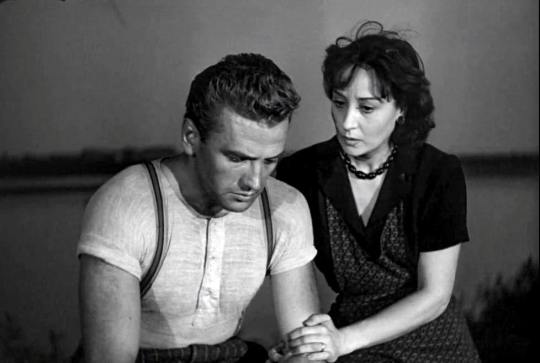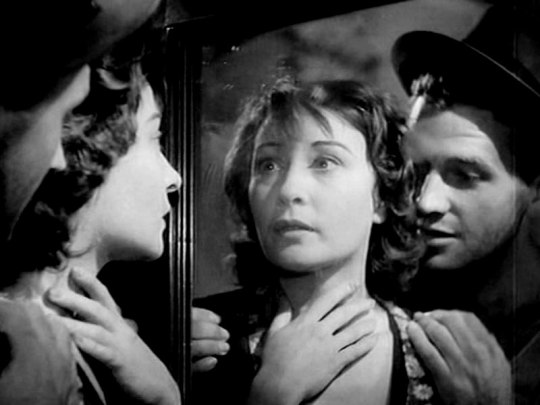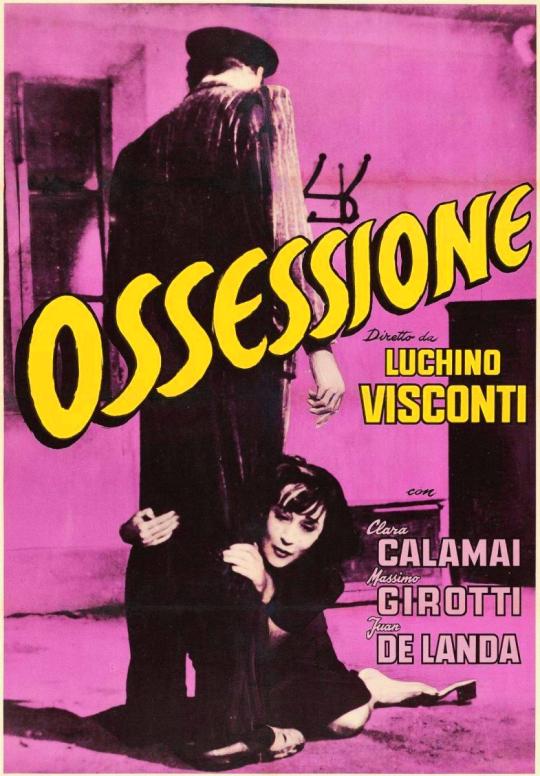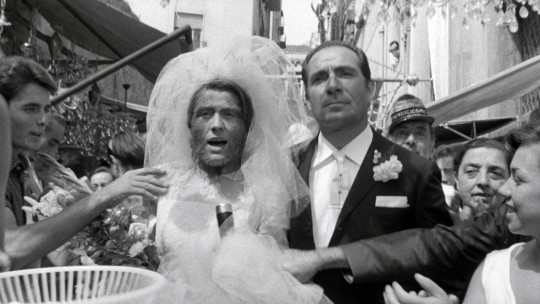#aldo tonti
Explore tagged Tumblr posts
Text

The Gates of Heaven (La porta del cielo), Vittorio De Sica (1945)
#Vittorio De Sica#Cesare Zavattini#Diego Fabbri#Adolfo Franci#Carlo Musso#Marina Berti#Massimo Girotti#Giovanni Grasso#Roldano Lupi#María Mercader#Carlo Ninchi#Elli Parvo#Aldo Tonti#Enzo Masetti#Mario Bonotti#1945
2 notes
·
View notes
Text
Barabba (1961) Richard Fleischer
La scena è stata girata dall'operatore Aldo Tonti sulle colline di Roccastrada in Toscana, il produttore Dino De Laurentiis ebbe l'idea di girarla durante l'eclisse totale di sole del 15 febbraio 1961.
11 notes
·
View notes
Text

Ingrid Bergman in Europa '51 (Roberto Rossellini, 1952)
Cast: Ingrid Bergman, Alexander Knox, Ettore Giannini, Giulietta Masina, Teresa Pellati, Marcella Rovena, Tina Perna, Sandro Franchina. Screenplay: Roberto Rossellini, Sandro De Feo, Mario Pannunzio, Ivo Perilli, Brunello Rondi. Cinematography: Aldo Tonti. Production design: Virgilio Marchi. Film editing: Jolanda Benvenuti. Music: Renzo Rossellini.
The films Roberto Rossellini made during his affair with and marriage to Ingrid Bergman have an everlasting fascination for movie buffs because of their clash of styles: Bergman's Hollywood-style star glamour and Rossellini's gritty, improvisational neo-realism. But they have few real enthusiasts except for critics inclined toward the auteur theory. For many movie-watchers they seem like failed experiments. But Europa '51 seems relatively coherent, tracing the journey of Bergman from grief at the loss of her child to a kind of beatific transcendence, although even a sympathetic critic like James Harvey, in his fine discussion of the Bergman-Rossellini oeuvre in his book Watching Them Be, finds the screenplay "Like a play of ideas without the ideas." I don't think that's entirely fair: It seems to me that Europa '51 is crowded with ideas to the point that it becomes a movie about the failure of ideas -- or rather ideology. Nothing suffices to explain Irene Girard's (Bergman) drive toward saintly service -- she helps a poor family pay for the medical treatment of a child; she befriends a young woman (Giulietta Masina) to the point of filling in for her one day at the woman's job in a horrifying factory; she helps a young hoodlum elude the police; she nurses a dying prostitute -- all of which appalls her husband (Alexander Knox) and her wealthy family. Not religion, not politics, not psychoanalysis serves to explain or justify her actions, at least in the eyes of the church, the state, and the medical establishment. Or, for that matter, in her own eyes. She doesn't know why she becomes a secular saint, and this of course means she winds up in a mental institution -- where she continues to radiate benevolence even toward the tormented inmates. David Thomson, one of the film's admirers, says, "It's a movie that resonates with the deep-seated urge for moral reform after the war." But ultimately it also seems to me to forecast the failure of any attempt at moral reform. It might be instructive to watch this movie in tandem with a slightly later examination of the moral malaise of postwar Europe, La Dolce Vita (Federico Fellini, 1960).
2 notes
·
View notes
Text

#ProyeccionDeVida
🎥 El Neorrealismo Italiano, presenta:
🎬 “OBSESION” [Ossessione]
🔎 Género: Drama / Intriga / Cine Negro / Crimen / Neorrealismo
⏰ Duración: 121 minutos
✍️ Guión: Luchino Visconti, Giuseppe de Santis, Mario Alicata, Gianni Puccini y Antonio Pietrangeli.
📕 Novela: James M. Cain
🎼 Música: Giuseppe Rosati
📷 Fotografía: Aldo Tonti y Domenico Scala (B&W)
🗯 Argumento: Giovanna (Clara Calamai) es una hermosa joven malcasada con el viejo propietario de un restaurante. Su sórdida vida cambiará con la aparición de un vagabundo que se convierte en su amante y al que inducirá a matar a su marido. Adaptación de la novela de James Cain "El cartero siempre llama dos veces".

👥 Reparto: Massimo Girotti (Gino Costa), Clara Calamai (Giovanna Bragana), Dhia Cristiani (Anita), Juan de Landa (Giuseppe Bragana), Elio Marcuzzo (Spaniard), Vittorio Duse (Lorry Driver), Michele Riccardini (Don Remigio), Michael Balfour y Michele Saraka.
📢 Dirección: Luchino Visconti
© Productora: Industrie Cinematografiche Italiane
🌏 País: Italia
📅 Año: 1943

📽 Proyección:
📆 Jueves 18 de Abril
🕡 6:30pm.
🏡 Auditorio Leonardo Da Vinci del Instituto Italiano de Cultura (av. Arequipa 1055, Urbanización Santa Beatriz - Lima)
🚶♀️🚶♂️ Ingreso libre

👀 A tener en cuenta: Película dirigida a público mayor de quince años. (15+)
0 notes
Video
youtube
Lo scatenato - Luis Bacalov - 1967
TONINO GUERRA
FILM DI FRANCO INDOVINA
LUIGI MALERBA MARIO CECCHI GORI ALDO TONTI MARCELLO MALVESTITO PIERLUIGI PIZZI
Vittorio Gassman: Bob Chiaramonte Martha Hyer: Luisa Chiaramonte Gila Golan: Emma Karin Skarreso: modella Massimo Serato: agente Carmelo Bene: prete Steffen Zacharias: ispettore di Polizia Jacques Herlin: professore di zoologia Claudio Gora: ministro Gigi Proietti: truccatore Giovanni Ivan Scratuglia: Gianfranco (con il nome Ivan Scratuglia) Mario Cecchi Gori: pubblicitario Aldo Tonti: regista Piero Vida: The Pennies: la band Lo scatenato è un film del 1967 diretto da Franco Indovina.
Bob Chiaramonte è un famoso attore di varie pubblicità, che però pian piano inizia ad impazzire. Infatti egli sembra essere perseguitato da normali animali che non lo vedono di buon occhio. Un toro ad esempio getta Bob in un fiume, mentre dei topi rosicchiano una corda che tenevano lui appeso ad un elicottero per girare una pubblicità. Quando Bob si rifiuta di girare altre pubblicità con degli animali come comparse, viene immediatamente licenziato. Sul punto della disperazione, entra in scena una comunissima mosca, che inizia a tormentare la vita del povero Bob che cerca di ucciderla in ogni modo, senza riuscirci. Quando la mosca scompare, Bob continua ugualmente a sentire il fastidioso ronzio, menando le mani ovunque come un vero folle. Ormai impazzito del tutto, Bob si reca allo zoo ed in una sorta di monologo cerca di dimostrare ad una scimmia in gabbia la superiorità dell'uomo sull'animale. Come risultato, Bob finisce in gabbia al posto della scimmia.
0 notes
Photo





Il lupo della Sila (Duilio Colletti, 1949)
44 notes
·
View notes
Photo

Federico Fellini, Le Notti di Cabiria, 1957
#film#federico fellini#le notti di cabiria#nights of cabiria#aldo tonti#otello martelli#giulietta masina#italian cinema#italian neorealism#neorealism#50s#film still
4 notes
·
View notes
Photo










Le notti di Cabiria (Federico Fellini, 1957).
#le notti di cabiria (1957)#le notti di cabiria#nights of cabiria#nights of cabiria (1957)#federico fellini#giulietta masina#aldo tonti#leo catozzo#piero gherardi
195 notes
·
View notes
Photo










castle of the living dead (it/fr, kiefer 64)
#castle of the living dead#warren kiefer#donald sutherland#luciano pigozzi#gaia germani#philippe leroy#christopher lee#aldo tonti
25 notes
·
View notes
Photo

Franco Interlenghi, October 29, 1931 - September 10, 2015.
With Federico Fellini, Aldo Tonti, Valentina Cortese, Franca Marzi, Giulietta Masina, and Alberto Sordi.
#franco interlenghi#federico fellini#aldo tonti#valentina cortsese#franca marzi#giulietta masina#alberto sordi#cinema#film#movies
53 notes
·
View notes
Photo

Reflets dans un œil d’or / Un major rêve d’un intérieur blanc, viril, sans décor ni poussière.
#Reflets dans un œil d’or#Reflections in a Golden Eye#John Huston#Aldo Tonti#Oswald Morris#1967#Marlon Brando#Elizabeth Taylor#Brian Keith#Julie Harris#Robert Forster#Zorro David
0 notes
Text

The Ape Woman (La donna scimmia), Marco Ferreri (1964)
#Marco Ferreri#Rafael Azcona#Ugo Tognazzi#Annie Girardot#Achille Majeroni#Filippo Pompa Marcelli#Ugo Rossi#Ermelinda De Felice#Aldo Tonti#Teo Usuelli#Mario Serandrei#1964
1 note
·
View note
Photo

"Cast A Giant Shadow", 1966. Senta Berger as Magda Simon. Directed by Melville Shavelson. Cinematography: Aldo Tonti. United Artists
20 notes
·
View notes
Photo


Anna Magnani in the "Una Voce Umana" segment of L'Amore
Federico Fellini and Anna Magnani in the "Il Miracolo" segment of L'Amore
L'Amore (Roberto Rossellini, 1948)
Una Voce Umana Cast: Anna Magnani. Screenplay: Roberto Rossellini, Anna Benevuti, based on a play by Jean Cocteau. Cinematography: Robert Juillard, Otello Martelli. Production design: Christian Bérard. Film editing: Eraldo Da Roma. Music: Renzo Rossellini Il Miracolo Cast: Anna Magnani, Federico Fellini, Peparuolo, Amelia Robert. Screenplay: Roberto Rossellini, Federico Fellini, based on a novel by Ramón del Valle-Inclán. Cinematography: Aldo Tonti. Art direction: Christian Bérard. Film editing: Eraldo Da Roma. Music: Renzo Rossellini. Roberto Rossellini's L'Amore, designed as a tribute to Anna Magnani, comprises two short films, Una Voce Umana and Il Miracolo. The first is based on Jean Cocteau's monodrama La Voix Humaine and its cast consists entirely of Magnani as a woman whose lover is not only breaking up with her but also going off to marry another woman. In a long telephone call she pleads with and rages at him. In Il Miracolo, Magnani is Nannina, a simple-minded woman who, while herding goats in the hills above her village, encounters a hiker whom she takes to be St. Joseph. He gets her drunk and leaves her pregnant. (The hiker is played by 28-year-old Federico Fellini, who doesn't speak a word in one of his few on-screen appearances.) When Nannina learns that she's having a child she takes it to be a miracle from God, but the townspeople, who already treat her as the village idiot, torment her so much that she flees into the hills, where she gives birth in what seems to be an abandoned monastery. In one of the landmark moments in the decline of film censorship, the Catholic National Legion of Decency charged Il Miracolo with sacrilege and persuaded the New York state film censors to pull it from release. The lawsuit brought by the American distributor, Joseph Burstyn, went all the way to the U.S. Supreme Court, which in 1952 ruled that the ban was an unconstitutional restriction on freedom of speech. Magnani's performance is fuller and more varied in Il Miracolo than in Una Voce Umana, in which she gives a lacerating performance that feels more theatrical than cinematic -- her torment becomes monotonous. But both films accomplish what Rossellini set out to do: showcase Magnani's intense commitment to her art.
13 notes
·
View notes
Text

Ossessione (1943) was photographed by Domenico Scala and Aldo Tonti. Dom had 67 cinematography credits from 1931 to 1967. Aldo had 136 cinematography credits from 1935 to 1979. Aldo's other notable credits are Roberto Rossellini's acclaimed Europe 51 with Ingrid Bergman, Fellini's Nights of Cabiria, and Reflections in a Golden Eye.
1 note
·
View note
Photo


Anna Magnani, Amedeo Nazzari and Mino Doro in Italian crime melodrama "Il bandito" (Alberto Lattuada, 1946).
The story is typical of many contemporary movies of the same period: it tells of a returning vet (Nazzari) who, unable to reintegrate into society, becomes a criminal... (I stop here). The critics of the afterwar didn't understand the values of this fine movie that tells a very pessimist story by a mise-en-scène that masterfully blends Italian neorealism and American noir suggestions. And the movie is also remarkable by the way it uses some great Italian stars "against type": the brilliant and handsome adventurer Amedeo Nazzari plays the disillusioned anti-hero; the honest popular commoner Anna Magnani here is the boss of the gang (!) while the candid and naive Carla del Poggio plays... a prostitute. And another well-accomplished motive is the fine photography (Aldo Tonti) that masterfully balances realism and expressionism in a movie absolutely worth to see.
0 notes